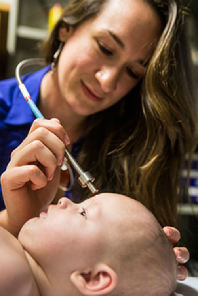Medisch Spectrum Twente, ZGT (Ziekenhuisgroep Twente) and the University of Twente launched a joint innovation fund.
Nienke Bosschaart was awarded a voucher for her project Meten zonder prikken. (Blood analysis without pain in neonates). The overall aim of this project is to develop a noninvasive alternative for invasive blood sampling in preterm babies.

The project aims to develop a fast and noninvasive alternative for these painful blood sampling using heel pricks. For this purpose, the technique low-coherence spectroscopy (LCS) will be employed. As with any other type of spectroscopy, LCS shines light on the skin and collects the back scattered photons. By combining spectroscopy with low-coherence interferometry, LCS measures the local absorption of light by bilirubin and hemoglobin inside blood vessels. Subsequently, this absorption is related to the individual concentrations of bilirubin and hemoglobin in blood.
Nienke will use the Pioneers in Healtcare voucher to build the first clinical LCS system. Together with Ageeth Kaspers (Neonatology, MST) and Bärbel van den Berg (Clinical Physics, MST) she will set up a patient study to validate the system on preterm babies.
Contact: Nienke Bosschaart (n.bosschaart@utwente.nl)
_____________________________________________________________________________________
Srirang Manohar was awarded a voucher for his project State-of-the-art in photoacoustic ct to visualize the synovium in inflammatory joint disease. The project is a collaboration between Christoph Brune (Applied Analysis, UT) and Hein Moens (Ziekenhuisgroep Twente, ZGT, Alemelo)
In the project, mathematics and imaging technology specialists come together to develop high-accuracy photoacoustic imaging of the joints. The overall aim of this project is to develop a noninvasive method based on photoacoustic imaging for the visualization of the inflamed finger joint membrane in rheumatoid arthritis patients.

It is known that x-ray radiography is mainly sensitive to changes in joint spaces and bone erosion and is mainly applied for late stage disease monitoring. Ultrasound imaging is also less suitable due to low contrast between inflamed synovium and other soft tissues. MRI provides good visualization of the inflamed synovium, but is expensive, largely inaccessible, and requires contrast agents. The new method has the potential of addressing some of these drawbacks.
Contact: Srirang Manohar (s.manohar@utwente.nl)
_____________________________________________________________________________________
